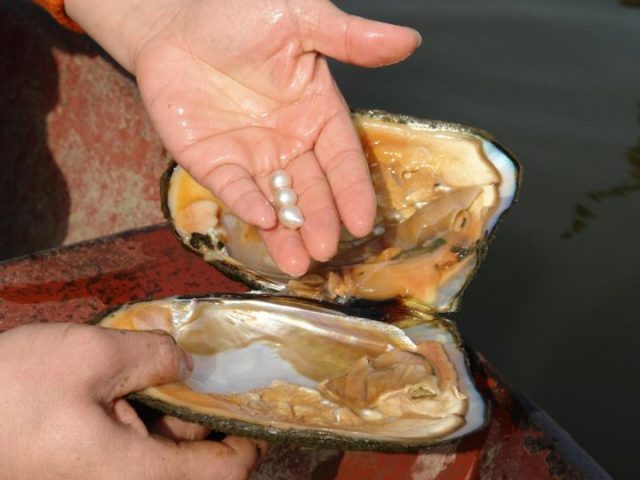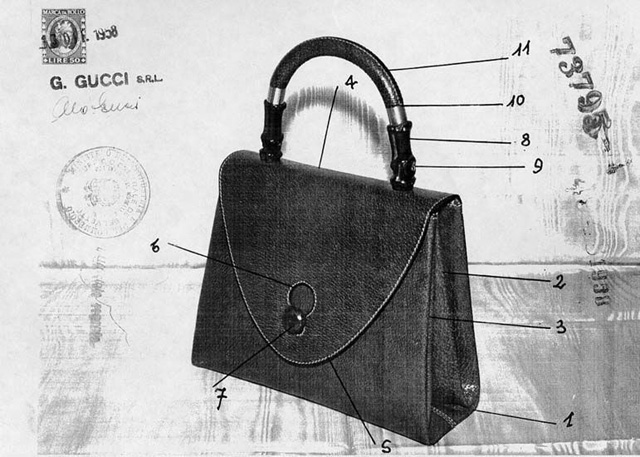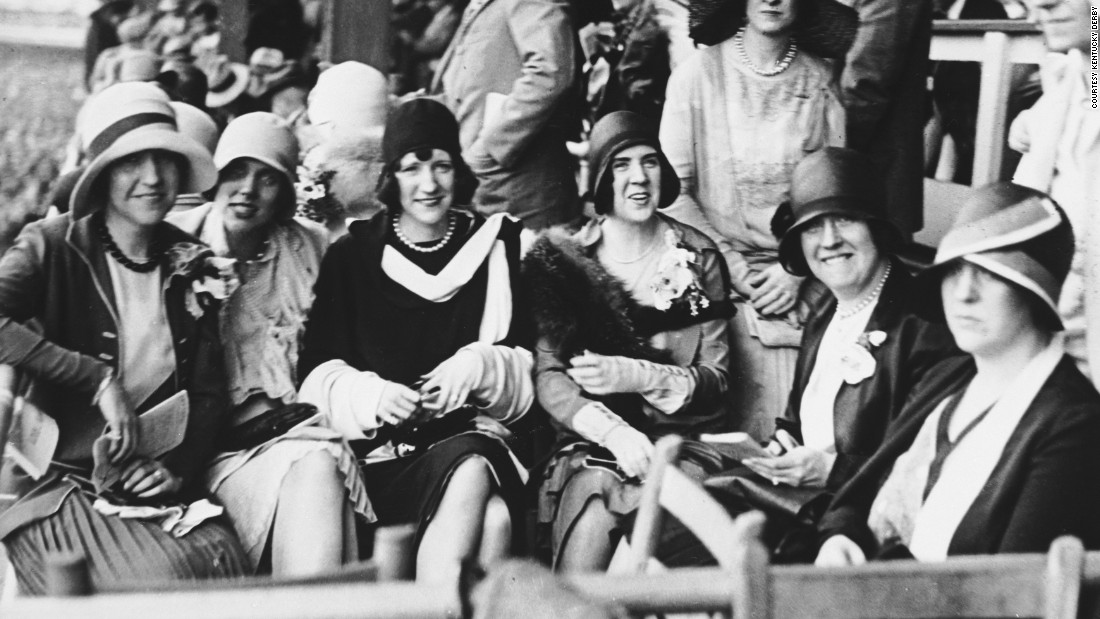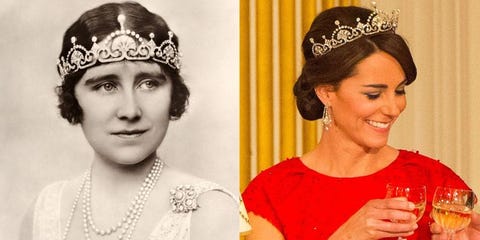talkingfashion » 1940s
-
Picturesque Pearls: A Style Guide
Picturesque Pearls: A Style Guide
By Paige McKirahan
With wedding season well on its way, we wanted to take a look at one of our favorite elegant motifs in accessories for these upcoming warm weather months. Since pearls first made their way into the realm of jewelry, they have been the true symbol of class and superiority; seeing has how the pearl is the world's oldest gemstone with traces back to 420 BC, this elitist undertone has deep historical roots. In the Byzantine empire, for example, it was dictated that only the emperor was permitted to wear pearls with other societies having similar laws. Until the 20th century, pearls were considered to be one of the most valuable gems on the market all over the globe; prior to this time, all pearls were naturally found in wild mollusks, making them more rare and coveted than ever.

Oldest pearl necklace in existence on display at the Louvre (source)
In ancient Greek culture and at the height of the Roman Empire, pearls were worn on gowns, necklaces, and were even used to decorate furniture in wealthy households. It was even said that Cleopatra preferred pearl jewelry above all others, and she went as far as dissolving one of her most priceless pairs of pearl earrings in a glass of wine before drinking it! This ancient popularity led to pearls being extremely favorable with the monarchy; pearls of all shape and color varieties were widely sought after, and many were coming directly from the Persian Gulf. The 16th century in England was even referred to as the Pearl Age, perfectly reflecting the gemstone's prestige at the time.

Cleopatra Dissolving the Pearl in Wine, Andrea Casali (source)
In the Victorian Age, seed pearls became more favorable than any of their counterparts on account of the fact that their small size made them perfect for jewelry and other accessories. They are typically no larger than 2mm in diameter, and they were widely associated with pure ideals. Royal love of pearls continued for generations, with Queen Victoria having an affinity for all things pearl. Prince Albert gifted her a pair of drop-style pearl earrings in 1847, and these are now owned and proudly worn by the reigning monarch, Elizabeth II.
It wasn't until the late 1800s that pearls became a widely accessible material; in 1893, Kokicho Mikimoto discovered how to create cultured pearls, prompting the creation of over 350 pearl farms across Japan by 1935. This caused a widespread pearl mania that perfectly complemented contemporary culture all throughout the 1900s. From Coco Chanel's iconic 1936 portrait to Audrey Hepburn's emblematic look in Breakfast at Tiffany's, pearls became a true symbol of luxury. This sophisticated aesthetic shifted with Alber Elbaz at the helm of Lanvin, where he reimagined the gemstones as a "cool girl" motif rather than something you would find in your grandmother's jewelry box. He truly spun their reputation into something journalists felt were "not like your mother's pearls", and the gemstone has been present in haute couture ever since.


Coco Chanel and Audrey Hepburn in pearls (source)
Now that we know the history behind the eponymous stone, its time to evaluate the types of pearls. They can now be produced in a variety of different ways, with each having its own special set of characteristics! Whether they are natural or cultured, they are formed when a mollusk produces layers of nacre around molecules inside of the shell. The quality of the nacre is what controls the level of the pearls shine, which can cause it to decrease or increase in value. High-quality pearls should be smooth and blemish free, with shapes ranging from round to misshapen. Misshapen pearls are considered to be baroque, after the art movement. Lastly, a pearl set in necklaces can be uniform with all pearls at the same size, or graduated, meaning they change uniformly from the end to the center. With this education in mind, let's take a look at the specific types of pearls on the market!

(source)
Natural Pearls
Natural pearls are the rarest type, with many historically being found in the Persian Gulf. Though many have already been harvested, you may be able to purchase these small gemstones, but they will cost you a pretty penny!
Cultured Pearls
Cultured pearls are grown in farms, with the mollusks containing them being raised until they reach the point of being able to accept the mother-of-pearl bead nucleus. The pearl technician then implants the bead and returns the mollusk to water to form the gem. Not all cultured pearls are of high quality, and it can take tens of thousands of pearls to compile a group similar enough to use in jewelry.
Saltwater Pearls
Many countries grow cultured pearls in their saltwater seas. Japan and China produce cultured pearls that can range from 2 mm to 10mm in size, and are usually white in color. Australia, Indonesia, and the Philippines produce the largest of all cultured pearls. They are considered the "South Sea pearl" and can get up to 20 mm with colors ranging from white to cream to gold. There are also saltwater pearls grown in the islands of French Polynesia, with their sizes ranging from 8mm to 16mm. They can be naturally black, but they typically can be gray, blue, green, or purple.
Freshwater Pearls
Freshwater pearls mostly hail from China and are grown in lakes, rivers, and ponds all over the continent. Many are white and similar in size to Akoya pearls in size and shape, and usually, have a thicker nacre on account of them not having a bead nucleus.
Imitation Pearls
Imitation pearls usually have a high luster and are coated glass beads. You can tell these apart from cultured or natural pearls, but it may prove to be difficult based upon how the pearls were treated. For tips on how to analyze your pearls, click here!
We hope that this gave you a better insight into all things pearls! We now have a little bit of pearl mania and if you do too, be sure to check out our selection of pearl accessories!
Sources:
Luna, B. (2015, August 10). The History Of Pearl Jewelry. Retrieved from https://www.ritani.com/blog/gemstone-jewels/the-history-of-pearl-jewelry/Perron, C. (2017, December 08). The History and Symbolism of Pearl Jewelry. Retrieved from https://www.brilliantearth.com/news/the-history-and-symbolism-of-pearl-jewelry/N/A. (2018, June 08). The Evolution of Pearl Jewelry in Fashion. Retrieved from https://www.crfashionbook.com/fashion/a21098608/pearl-jewelry-fashion-history/ -
Guccio Gucci the Great: Five Facts About Fashion’s Finest
Guccio Gucci the Great: Five Facts About Fashion’s Finest
By Paige McKirahan
As a plethora of designer birthdays are on the horizon this spring, we wanted to remember one of our favorites that were born on March 26th; Guccio Gucci, the infamous creative mind behind the House of Gucci was born in 1881 in Florence, Italy to a family with a history in leather craftsmanship. Though Guccio passed away over 50 years ago in 1953, his eponymous namesake brand lives on and continues to dominate the luxury market. Prior to his death, he remained at the head of the brand and molded Gucci into the haute couture powerhouse that it is today. Read on to find out some fast facts about this fashion favorite and brush up on your industry trivia!
In 1921, Gucci opened his first shop in Florence, Italy

Guccio and his son Rodolfo in front of an early Gucci store, 1938 (source)
This first leather-focused boutique laid the foundation for the House of Gucci as its quality goods allowed Guccio to build a reputation around his dedication to detail. He was known to employ only the best craftsmen from his neighborhood, and he created small leather accessories that quickly garnered him local fame.
In 1932, he created the "it" loafer.
After word began to spread about his brand, many people were traveling all over the world to purchase his designs in Florence. During this time, he created the loafer shoe with a gilded snaffle; this was the first of its kind and became such a staple in everyday footwear to this day is still the only shoe on display in New York's Museum of Modern Art.
Guccio and his wife, Aida, had a large family.
The Gucci Family (source)
Lucky for the Gucci's, they easily could keep the company in the family as their six children- four sons and two daughters- were the perfect successors. Following Guccio's death, his four sons, Aldo, Ugo, Vasco, and Rodolf, dramatically took over operations at the fashion house.
Guccio introduced the iconic bamboo handled bag in 1947.

Gucci bamboo patent form (source)
As the brand's first iconic bag, this accessory made huge waves in the industry as it was a previously unseen style. This design has been a mainstay at the company since its conception and is a popular choice by modern fashionistas all over the world.
Guccio's brand is owned by Kering.
The Gucci brand is now owned by a parent company with an affinity for luxury fashion. In addition to Gucci, Kering also owns Bottega Veneta, Yves Saint Laurent, Sergio Rossi, Stella McCartney and Alexander McQueen! Who would not love to be a part of this exclusive club?
We hope that these fast fashion facts gave you a new look into the life of Guccio Gucci and that you learned something new with us at TalkingFashion today! For a timeline of Guccio's life, click here!
Sources:
“10 Facts About Guccio Gucci -- Know Your Fashion Designers.” College Fashion, 25 Feb. 2019, www.collegefashion.net/news/know-your-fashion-designers-10-facts-about-guccio-gucci/.Pmc. “Gucci: A History Lesson.” WWD, WWD, 23 Feb. 2011, wwd.com/fashion-news/designer-luxury/history-lesson-3512770/.“Who Was Guccio Gucci? Everything You Need to Know.” – Facts, Childhood, Family Life of Italian Fashion Designer & Entrepreneur, www.thefamouspeople.com/profiles/guccio-gucci-18526.php. -
Fashion Flashback: The Hot History of Hats
Fashion Flashback: The Hot History of Hats
By Paige McKirahan
To continue on with our historical evaluation behind some of the most iconic accessories of all time, it would only be appropriate to reflect on how hats came to be in celebration of Hat Day! Whether they be worn for fashion, protection, ceremonies, rituals, or utilitarian purposes, these head coverings have been a staple in the industry for thousands of years. Of course, this long history starts in ancient Egypt; one of the first images depicting a hat can be found in Thebes tomb and this illustration shows a man wearing a conical straw hat. They also first appeared in an early illustration of Pileus which depicted him wearing a simple small cap.

Ancient Egyptian Headwear (source)
In this time and throughout history, one of the most popular materials for hats is felt. The ancient Egyptians and Native Americans first discovered this material when they discovered that camel hair, when compacted into the floors of their sandals, contributes to the creation of this material. St. Clement, the patron saint of felt hat makers, was said to encounter the material in a similar fashion after filling his shoes with flax fibers.
In these ancient times, hats were generally worn either to signify high status or for protection from the elements. In Ancient Rome and Greece, Phrygian caps also referred to as Liberty caps, were used as symbols of freedom for exonerated slaves. The first brimmed caps were found in Ancient Greece and were worn by those seeking to protect themselves from the sun, typically those working in fields or in construction.
As headwear began to evolve, gendered styles came into play during the Middle Ages; women were wearing a variety of new head covering designs ranging from veils to wimples. Later in those years, women’s hats transformed into elaborate displays of wealth that sometimes featured two horn-like decorations or conical shapes.

Middle Ages Hat Styles (source)
The 18th century birthed newer designs created by milliners; the term was created to describe products made in Milan and other Northern Italian regions that were made with high-quality materials. One of the most popular hats of this time was the Shepherdess hat, which featured a large, sun-blocking brim. Bonnets were as popular women’s in fashion as top hats were for men, and both were made from silk at the time. Silk top hats were so popular and awe-inspiring that a man wearing once caused such a stir in the streets he earned himself a 500 dollar fine from inciting panic!
In the following century, hat’s widespread popularity began to rise and was considered to be very fashionable as more designs become available. Women’s hats started growing in size and opulence with many including feather details, circular constructions, and varying brim styles. Brim sizes saw a decrease with the introduction of the parasol umbrella, and then grew again as the 20th century grew closer. Hats also began adapting to popular hairstyles, accommodating new cuts and fashions as to not disturb one's overall look. The first Kentucky Derby occurred in this century and established itself as the largest hat fashion event in America (and it still is to this day!).

The 20th century saw hats in a new light entirely. Wars, constant rationing, and accompanying social and cultural changes had a huge impact on all aspects of fashion, including headwear. The cloche hat peaked in popularity, and round hats with decorative flowers were another favorite of fashion lovers everywhere. Towards the middle of the century, fashion icons like Jackie Kennedy popularized the pillbox hat, which was followed by the fedora for both genders. Berets, top hats, sombreros, western hats, and ball caps all fluctuated in popularity during this time, and some of these styles are still very well received by the public.
Today, hats are still a hugely popular accessory and have been made staples in many sporting, cultural, and social events. They aren’t typically worn for ornamental purposes with as much gusto as they once were, but sports caps, beanies, and sun hats are beloved accessories for casual wear in modern times. To get a piece of fashion history to have as your own, check our collection of hats
Happy Hat Day TalkingFashion Peeps!
Sources:
A Brief History of Hats. (2011). Retrieved from http://hatbox.com/hat-history.cfmHistory and Origin of Hats. (n.d.). Retrieved from http://www.historyofhats.net/hat-history/who-invented-hats/ -
The Heady History of the Hand Fan
The Heady History of the Hand Fan
By Paige McKirahan
When considering all of the accessories that are used for both utilitarian and decorative purposes, one of the first to come to mind is that of the hand fan. Though this ornamental piece was widely popular in Victorian Eras as a foreign symbol of wealth and class, their origin lies centuries prior in ancient Egypt, Greece, and Rome. After two elaborate fans were discovered in King Tut’s tomb, their gilded appearance solidified the fan’s prominent presence in the accessory world.

(photo credits to pinterest.com)
The fan, which was originally thought be a sacred instrument, was used in religious ceremonies and by royalty in noble settings. They were also used in China in association with ancient mythical and historical characters. At their conception, they were fixed and remained as so until Chinese culture birthed the folding fan and spread it westward towards Europe. Both Chinese and Japanese legends credit their respective countries with creating the piece; the Japanese feel that the folding style is modeled after the wings of bat, and the Chinese legend claims the idea stemmed from a woman fanning her face at a festival.

(photo credits to clickpicx.com)
The 17th century then saw an increase in the use of folding fan, eventually causing fixed fans to become obsolete. This style was brought to Western cultures by merchant traders and religious missionaries, and prompted the development of the printed fan, which was made available to all classes. They generally featured prints of all kinds, either painted or transferred on, and shifted from biblical tradition to contemporary pastimes. The Impressionist, Art Nouveau, and Art Deco movements highly impacted the design and construction of fans from the 19th to the 20th century . The 19th century boast some of the most lavish fan designs in history and they were usually hand painted, furnishing those in royal positions. In the 20th century, feathered fans became popularized by those in high society and ostrich plums could be see floating through the air at every Moulin Rouge show!
Even though fans are not presently part of the everyday fashionista’s accessory arsenal, they still can be seen at royal events and in haute couture shows. We here at TalkingFashion think that something so grand should never go out of style, so to get your own fashionable fan, check out our fantastic collection here!
Sources:
History of Fans. (n.d.). Retrieved from https://www.thefanmuseum.org.uk/fan-history
A Brief History of the Hand Fan. (2008). Retrieved from https://web.ics.purdue.edu/~salvo/@SEA/exhibit/history.asp
-
Headpiece Heaven: Five Fabulous Ornamental Accessories
Headpiece Heaven: Five Fabulous Ornamental Accessories
By Paige McKirahan
When it comes to the evaluation of headwear as an accessory rather than something worn out of necessity, it can truly make or break an outfit. Adding a scarf or hat to compliment a piece is customary, but what about more lavish head ornaments that are typically sported by royalty or those strutting the red carpet? Read on to learn about hair and head ornaments that emulate opulence from the top down!
This eclectic headwear is a more decorative alternative to the hat. Its roots can be traced back the Renaissance where it was customary for Christian women in Europe to sport head coverings. The use of the term came into circulation to describe the evolutionary form of this headpiece towards the end of the 20th century. Presently, it is typically worn at events where hats are customary and is accompanied by formal attire. They are commonly worn by woman as a covering during church services, weddings, or horse racing events. They are seen in great volume at royal events and Princess Beatrice of York wore a piece to Prince William and Catherine Middleton’s wedding that was so unusual, it became an internet sensation!
Tiara:
A tiara is a specific type of crown that tends to be bejeweled and ornamental in style. Appropriate for formal occasions of the white tie variety, this headpiece originates in Persia as a status symbol. The use of tiaras in ancient times declined with the rise of Christianity, but they saw a revival in the 18th century when Neoclassicism popularized the accessory for female adornment. Despite the fact that this revival was geared toward royalty, this piece has also been worn by wealthy commoners. The style is popular in the costume jewelry industry where they are worn by women for special occasions including homecomings, proms, quinceaneras, pageants, or weddings.

(image credits to harpersbazaar.com)
Hairpin:
The hairpin can come in many forms, but its basic function remains the same: to hold one’s hair in place. Whether the piece is elaborate and ornamental or utilitarian like a bobby pin, they are essential in creating different hairstyles. Coming from ancient Egypt and China, they were worn by all genders and were essential to hairstyling. They can also be used to note one's social or marital status. Now, they have a more decorative appearance and can be in the form of a barrette, bobby pin, or classic long straight pin.

(image credits to pinterest.com)
This hair accessory can be considered a variation of the hairpin; it is decorative and functional, with its main purpose being to hold a hat to the head. It was invented in Britain in the early 1800s and after its conception, the demand grew so great that a machine was created so it could be mass produced. In the late 1800s, bonnets became widely more circulated than hats, forcing hairpins into the closets of millions. They continued growing in popularity until the early 1900s until women began using them for self-defense purposes. They then began being regulated and their length decreased in order to deter wearers from using them as weapons.
Crown:
As the most traditional of headpieces on this list, the crown is a symbolic headwear typically won by royals. They represent power, victory, honor, glory, and legitimacy, and are often emblematic of the monarchy. These pieces can feature natural motifs, and they often are adorned with an assortment of expensive jewels. There are a variety of crown types and they can be used in coronations, at state occasions, or during weddings. You can even find their style being copied for novelty events (think Burger King's kid crowns!)

(image credit to us.hellomagazine.com)
Has Megan Markel and Harry's wedding got you feeling headpiece crazed? We can sate your desire for this royal glamour from the top down! Take a look at our collection to find headpieces for every occasion!







